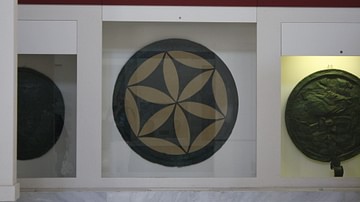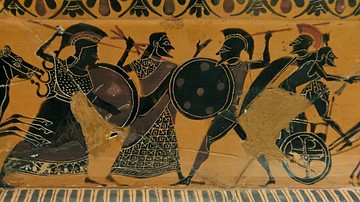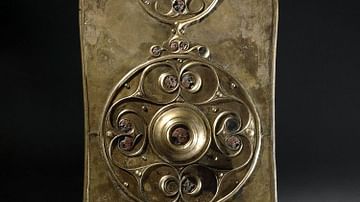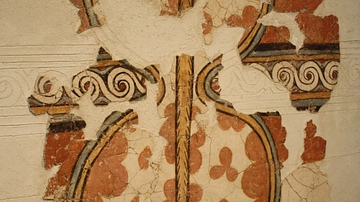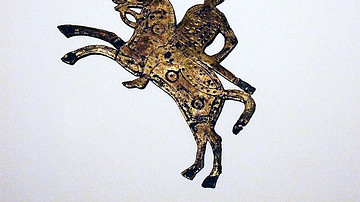Illustration
Bronze shield, Crete, Geometric period, 8th-7th century BCE.
Heraklion Archaeological Museum, Crete.
The bronze tympanon/shield found in the Idaean Cave is a votive offering from around the 8th century BCE. It is decorated with a bas-relief image of a male god climbing on or jumping over a bull, a spectacle of physical prowess seen in the Minoan wall-painting. The god holds a lion above his head and has two winged daimons on both sides who shake their tympana, perhaps in his praise. Sculpted images of the royal lion hunt and griffin-like deities have gigantic parallels in Assyrian art. The composition, decoration, and iconographic symbolization of Zeus and the kouretes in this carving, on the other hand, reflect the local Greek culture that succeeded, and profoundly absorbed, the Minoan civilization in Crete. Artistic and religious artefacts found in the Idaean Cave, including oil lamps, drinking vessels, altars, and votive gifts of gold, bronze, faïence, and ivory, link this Cretan location to a range of Mediterranean and Near Eastern influences coming from the Egyptians, Syrians, Palestinians, and Phoenicians, among others.
Cite This Work
APA Style
Heraklion, A. M. o. (2021, February 26). Minoan Bronze Shield. World History Encyclopedia. Retrieved from https://www.worldhistory.org/image/13483/minoan-bronze-shield/
Chicago Style
Heraklion, Archaeological Museum of. "Minoan Bronze Shield." World History Encyclopedia. Last modified February 26, 2021. https://www.worldhistory.org/image/13483/minoan-bronze-shield/.
MLA Style
Heraklion, Archaeological Museum of. "Minoan Bronze Shield." World History Encyclopedia. World History Encyclopedia, 26 Feb 2021, https://www.worldhistory.org/image/13483/minoan-bronze-shield/. Web. 06 May 2025.


